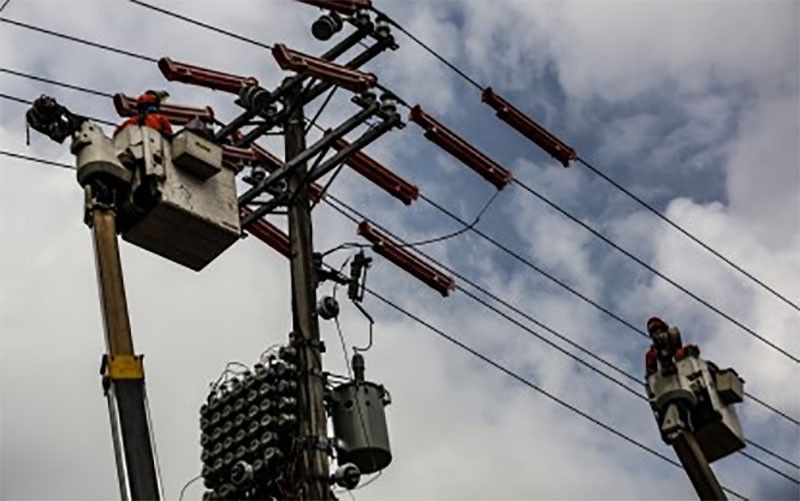DOE assures public: ‘No power crisis amid El Niño’

MANILA, Philippines — The warm or dry season has officially begun, the Philippine Atmospheric, Geophysical and Astronomical Services Administration (PAGASA) declared in the last week of March.
This is evident based on recent reports on heat index, with areas within the country reaching to 46 degrees Celsius – considered as “danger level.”
Following the beginning of the El Niño phenomenon comes jitters on the country’s power supply.
With rising temperatures come rising electricity consumption, as air conditioners, electric fans and other cooling equipment are being utilized to beat the heat, thus erasing any evidence within a room of such discomfort that the scorching sun has brought to the consumers.
Otherwise, consumers would move on with their day sweltering, clothes sticking to their back because of sweat.
As rooms cool down and sweat on everyone’s bodies disperse, power consumption reaches its peak.
“Challenges in our energy sector this summer stem from increased cooling demands, straining our power supply,” Think tank Center for Energy Research and Policy (CERP) convenor Noel Marabut Baga told The STAR.
With the higher cooling demand comes a question: is there a power crisis in the Philippines amid this year’s El Niño?
Department of Energy (DOE) Assistant Secretary Mario Marasigan’s answer is “No.”
“There is no power crisis in the Philippines,” Marasigan said in an interview.
The DOE official said the country has enough power supply amid the El Niño phenomenon.
This concern is rooted in the country’s history with power outages, caused by a high demand and a low supply of energy.
Take for example what happened in 1992, which was accounted in Philippine history as one of the “dark days” in the Philippines.
“In the worst years of the Philippine energy crisis – in 1992 and 1993 – electric power was rationed among industrial and commercial/residential users as eight to 12-hour brownouts occurred daily in Metro Manila and other population centers,” former president Fidel V. Ramos said in an article he authored titled Lessons from the Philippine electricity crisis.
Ramos said that most industrial activities were “stifled by the unstable power supply.”
According to the former president, workers have lost their jobs or livelihood as shops closed down due to the lack of business.
His accounts of the crisis also indicated that companies had to reduce working hours.
Those were the “dark days,” in the Philippines’ energy sector, and in fact, it was certainly not the last.
Ten years later, a nationwide Luzon blackout forced millions of Filipinos to go on with their days in heat with no access to cooling appliances due to the lack of power.
According to a 2002 report by The STAR, electricity was cut at 10:57 a.m. on May 21, 2002, affecting around 40 million people and “inflicting significant damage to commercial life in Metro Manila and surrounding areas.”
These remain as examples on how power crises could affect the country.
This year, however, Marasigan said the Philippines has “enough” power supply amid the warm and dry season.
“We have sufficient supply as well as the reserve (market) at the moment based on our latest power outflow,” the DOE official said.
Among the DOE’s plans to avoid the power crisis, according to Marasigan, is making sure that the power generators, system operators and utility distributors are aware of the situation of peak demand.
Moreover, the DOE is also making sure that the power generators, system operators and utility distributors will comply with DOE’s advisories.
The agency advised concerned sectors to make sure their facilities are operating in full capacity, except hydropower facilities.
Marasigan said only hydropower facilities are allowed to conduct a preventative maintenance program, given that the warm season has caused water level to dip down.
The Pantabangan-Masiway Hydroelectric Power Plant in Nueva Ecija will suspend operations as the head water level nears critical level.
Preventive maintenance would be conducted while the power plant is not operational.
Moreover, the DOE is making sure that power lines remain online.
“The role of the DOE is to facilitate the entry of these power projects and to make sure that the needed interconnection lines are needed through coordination with the concerned entities,” Marasigan said.
The National Grid Corp. of the Philippines (NGCP) has completed a backbone project in the Cebu-Negros-Panay (CNP) area four days ahead of schedule.
DOE Undersecretary Rowena Cristina Guevara said the 230-kilovolt Stage 3 backbone project was completed on March 27, four days earlier than the end-March commitment made by the NGCP.
The DOE said in March that it is currently monitoring the power situation amid El Niño, reminding NGCP to complete the CNP backbone project and the Hermosa-San Jose 500-kV Transmission Project.
While the CNP backbone project is complete, the status of the Hermosa-San Jose transmission line remains static due to the temporary restraining order issued in favor of a property developer.
However, NGCP spokesperson Cynthia Alabanza said, “We are hoping that the TRO could be lifted immediately so that we can complete the second circuit.”
For now, Alabanza said the operating line in Hermosa-San Jose is “enough” to supply the current requirement.
Meanwhile, the Independent Electricity Market Operator of the Philippines (IEMOP) said in March that the Mindanao-Visayas Interconnection Project (MVIP) improved supply in the Visayas and Luzon grids.
The Mindanao to Visayas grid can import up to 450 megawatts, allowing Mindanao to have “enough supply,” IEMOP assistant manager of market simulation and analysis Chris Warren Manalo said.
“The excess capacity helps to augment the capacity needed in the Visayas and Luzon grid,” he added.
MVIP on average allowed 341 megawatts to be exported to Visayas, while the Leyte-Luzon High-Voltage Direct Current link connecting Visayas to Luzon provided additional 296 MW “to support meeting the demand in the Luzon grid,” according to IEMOP.
These projects have been reported to improve the power supply.
Against this backdrop, the question is: should we expect a yellow or red alert in the near future?
DOE’s Marasigan answered: “We do not see right now any potential yellow and red alert.”
However, the DOE official said they are preparing for the possibility despite the existing “sufficient supply to the demand.”
The DOE advised transmission network providers to be “on time” with its interconnection facilities for the new capacities, particularly those that are commissioning this summer period.
Meanwhile, the DOE said distribution utilities should be ready not only in terms of power lines but also in identifying “critical and vital” facilities such as hospitals and medical clinics.
“Just in case emergency supply is needed, they have generation sets on standby – ready and standby power in these (vital) facilities,” Marasigan said.
The recent grid projects like the MVIP completed in January and CNP Stage 3 Link on March 27 “could strengthen our resilience,” said Baga of think-tank CERP, sharing the view of Marasigan.
“The DOE and ERC’s (Energy Regulatory Commission) Interruptible Load Program (ILP) helps manage peak demand by allowing large consumers to use their own generators like shopping malls, mitigating strain on the grid,” Baga added.
Last week, the DOE directed NGCP and all distribution utilities (DUs) to be “fully ready” to implement the ILP amid the dry season.
In an advisory signed by DOE Secretary Raphael Lotilla, the DOE requested the NGCP and DUs to submit their updates on the registered ILP participants, including concerns and requests for support for utilities new to the activation of the program.
The National Electrification Administration was also tasked to provide necessary assistance to electric cooperatives during the activation of the ILP.
Now that the DOE is optimistic about this season’s power supply, what does this mean for the consumers?
In simple words, consumers may not expect any big power outages, as committed by the DOE.
“There is no need for consumers to expect big power outages,” Marasigan said.
While concerns on power supply should not burden the consumers, electricity users also have their own roles to play.
Baga, who previously worked as a lawyer at DOE, urged consumers to do their part in saving energy.
“To prevent such disruptions, it is vital to reduce electricity consumption in our households,” he told The STAR.
Consumers, according to CERP’s convenor, should remember to turn off lights in unoccupied rooms, and if possible, to use electric fans instead of air conditioning units at night.
The Manila Electric Co. (Meralco) also gave the same “tips” on how to conserve energy.
The “biggest share of electricity usage” for households is for cooling appliances such as refrigerators, electric fans and air conditioners, said Meralco head of utility economics Lawrence Fernandez.
“These appliances are also the most used during the summer (or warm and dry) season. Thus, it is important to keep such appliances in good condition through regular cleaning,” Fernandez told The STAR.
In a press conference last month, vice president and head of corporate communications Joe Zaldarriaga mentioned several practices for consumers to be able to save energy.
Zaldarriaga urged consumers to regularly check and clean air conditioners, unplug appliances when not in use, and use LED bulbs for lighting.
“They (consumers) can make energy efficiency part of their living, their way of life – that’s going to be a big help,” he said.
- Latest
- Trending
































